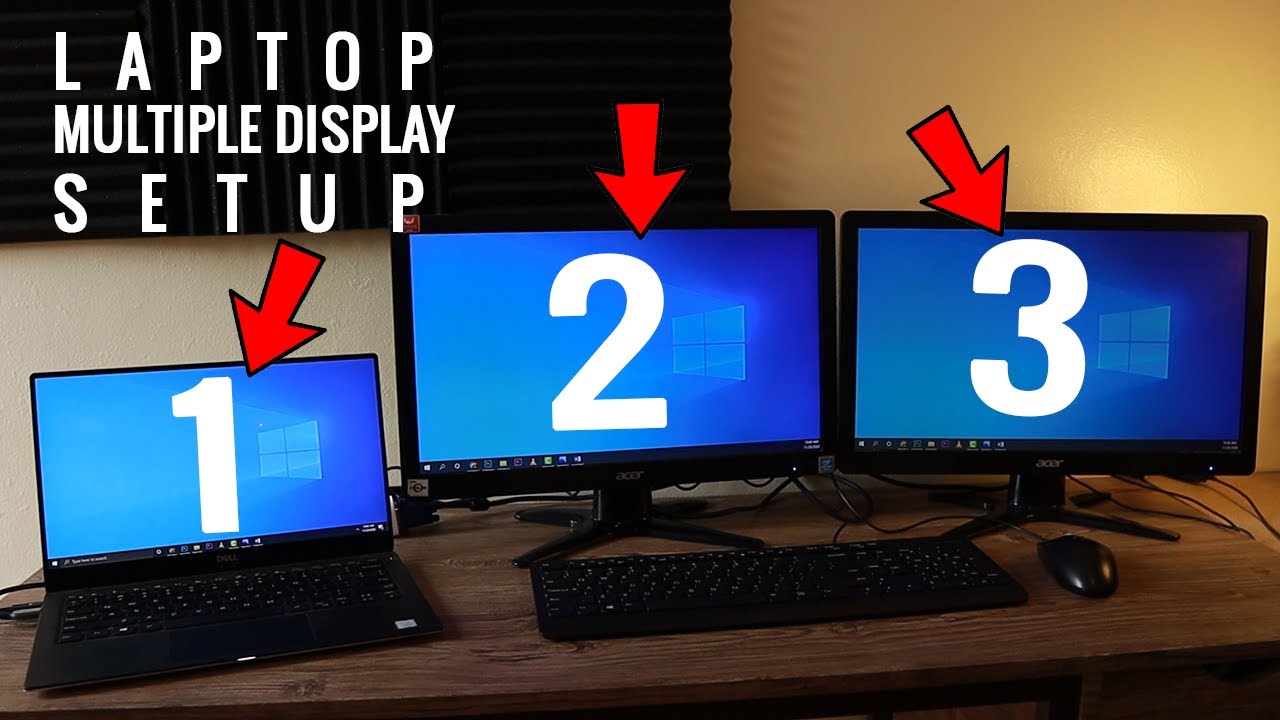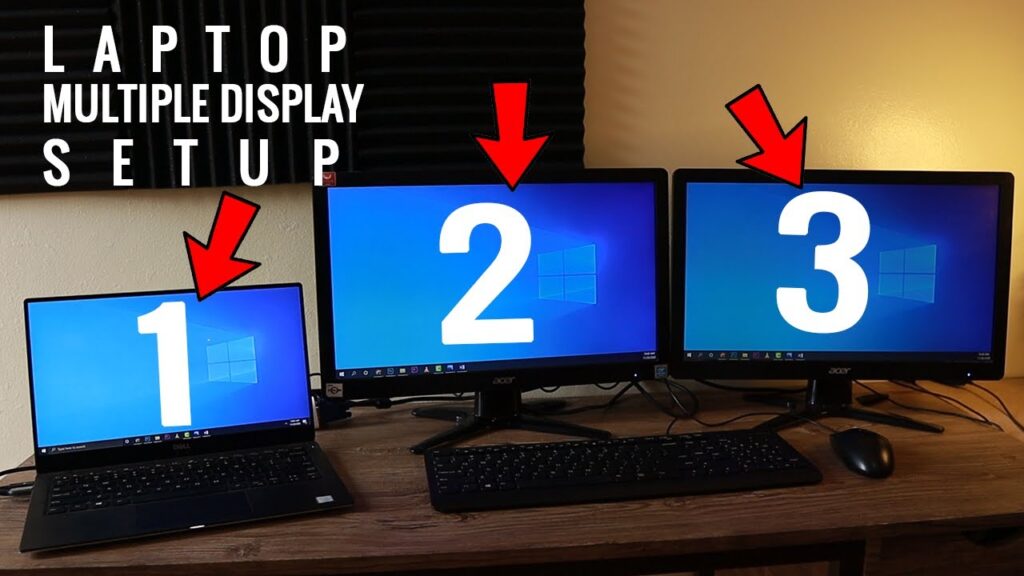
Hey there! If you’re looking to enhance your laptop setup, I’ve got just the thing for you. In this article, I’ll be walking you through the process of setting up multiple displays on your laptop, so you can maximize your productivity and enjoy a larger working area. Working on a compact laptop can sometimes be challenging, but by using an Anker USB C hub, you can easily connect multiple screens to your laptop and create a more expansive workspace. Whether you’re a multitasking pro or simply in need of a bigger screen, this setup will definitely help you get more work done efficiently. So, let’s dive in and explore how you can set up three multi-displays on your laptop using an Anker USB C hub. Get ready to take your productivity to the next level!
Setting up Multiple Displays on a Laptop

This image is property of i.ytimg.com.
Introduction
Setting up multiple displays on a laptop can greatly enhance your productivity and multitasking capabilities. Whether you’re working on multiple projects, editing videos, or simply need more screen real estate for a better workflow, adding extra monitors to your laptop can make a significant difference. In this comprehensive guide, we will walk you through the entire process of setting up multiple displays on your laptop, from choosing the right equipment to optimizing display performance. So let’s dive in and make the most out of your laptop setup!
Choosing the Right Equipment
Before you can start setting up multiple displays on your laptop, it’s important to choose the right equipment that is compatible with your laptop and meets your specific needs. Here are some considerations to keep in mind when selecting the equipment:
-
Laptop Compatibility: Check if your laptop has the necessary ports and capabilities to support multiple displays. Many modern laptops come with a USB C port, which is ideal for connecting external displays.
-
Researching USB C Hubs: USB C hubs are essential for connecting multiple displays to your laptop. Research different USB C hub models to find one that offers the necessary ports and features, such as HDMI or DisplayPort outputs.
-
Comparing Different Models: Compare the specifications and features of different USB C hubs to determine which one best suits your requirements. Look for models that offer the number of display outputs you need, along with additional USB ports and card readers if desired.
-
Alternative Options for Multi-Display Setup: If your laptop doesn’t have a USB C port or you prefer a different setup, consider alternative options such as docking stations or external graphics cards. These can provide additional display outputs and allow for a more versatile setup.
By carefully choosing the right equipment, you can ensure a seamless and efficient setup process for your multiple displays.
Setting up the Hardware
Once you have chosen the appropriate equipment, it’s time to set up the hardware for your multiple displays. Follow these steps to properly set up your laptop:
-
Preparing the Laptop: Make sure your laptop is turned off and disconnected from any power sources. This will prevent any potential electrical issues during the setup process.
-
Connecting the USB C Hub: Connect the USB C hub to your laptop’s USB C port. Ensure the connection is secure and that the hub is properly aligned with the port.
-
Identifying the Ports and Features: Familiarize yourself with the ports and features of the USB C hub. Take note of the HDMI or DisplayPort outputs, as these will be used to connect the external displays.
-
Connecting the Monitors: Take the HDMI or DisplayPort cables and connect them to the corresponding ports on the USB C hub. Then, connect the other end of the cables to the HDMI or DisplayPort inputs on each monitor. Ensure that the connections are secure and properly aligned.
-
Connecting Additional Accessories: If desired, connect any additional accessories such as keyboards, mice, or other peripherals to the available USB ports on the USB C hub.
By following these steps, you will have successfully set up the hardware for your multiple displays, laying the foundation for the next steps in the process.
Connecting the Displays
After setting up the hardware, it’s time to connect the displays to your laptop. Follow these steps to ensure a proper connection:
-
Determining the Available Ports: Identify the available ports on both the USB C hub and the external displays. This will help you understand the options for connecting the displays based on the available ports.
-
Using HDMI vs. VGA vs. DisplayPort: Choose the appropriate cable type based on the available ports. HDMI and DisplayPort cables are the most commonly used for connecting displays, as they provide high-quality video and audio signals. VGA cables, while more common on older displays, may also be used if necessary.
-
Configuring Cable Connections: Connect the appropriate cables to the HDMI, VGA, or DisplayPort outputs on the USB C hub. Then, connect the other ends of the cables to the corresponding inputs on the external displays. Ensure that the connections are secure and properly aligned.
-
Checking Cable Compatibility: Double-check that the cables you are using are capable of transmitting the necessary signals for your desired display configuration. Ensure that the cables support the required resolutions and refresh rates to avoid any compatibility issues.
-
Troubleshooting Common Connection Issues: If you encounter any issues during the connection process, such as displays not being detected or no signal being displayed, refer to the troubleshooting guide provided by the manufacturer of your USB C hub or consult online resources for potential solutions.
By carefully connecting the displays and ensuring compatibility, you’ll be one step closer to enjoying the benefits of a multi-display laptop setup.
Adjusting Display Settings
After connecting the displays, it’s important to adjust the display settings to ensure optimal performance and visual experience. Here are some settings to consider:
-
Accessing the Display Settings Menu: Right-click on your desktop and select “Display Settings” or “Screen Resolution” to access the display settings menu. Depending on your operating system, the menu options may vary slightly.
-
Understanding Display Resolution and Scaling: Adjust the display resolution and scaling settings to match the native resolution of each display. This will ensure that content appears sharp and properly scaled across all displays.
-
Choosing the Correct Screen Orientation: Select the desired screen orientation, such as landscape or portrait, for each display. This can be particularly useful if you have displays with different orientations or if you prefer a specific orientation for your workflow.
-
Adjusting Brightness and Contrast: Fine-tune the brightness and contrast settings on each display to achieve optimal visual comfort. This will help reduce eye strain and enhance the overall viewing experience.
-
Calibrating Color and Contrast Settings: If color accuracy is important for your work, consider calibrating the color and contrast settings on each display. There are various software tools available that can assist in calibrating colors and achieving accurate color reproduction.
By adjusting the display settings to your preferences and requirements, you can optimize the visual experience and ensure that your displays are set up just the way you want them.
Extending vs. Duplicating Displays
One key aspect of setting up multiple displays on a laptop is deciding between extending or duplicating the displays. Here are some considerations to help you make the right choice:
-
Understanding the Difference: Extending displays allows you to use each display as a separate workspace, effectively increasing your screen real estate. Duplicating displays, on the other hand, mirrors the content on all connected displays, providing an identical view on each screen.
-
Advantages and Disadvantages of Each: Extending displays enables multitasking and improves productivity by allowing you to spread your work across multiple screens. Duplicating displays, on the other hand, can be useful for presentations or situations where you want to show the same content to multiple people.
-
Determining the Optimal Mode for Your Workflow: Consider your specific workflow and the tasks you frequently perform. If you often work on multiple projects simultaneously, extending displays may be more beneficial. If you primarily use your displays for presentations or need an identical view across all screens, duplicating displays may be the better option.
-
Switching Between Extended and Duplicate Display: Most operating systems offer straightforward options to switch between extended and duplicate display modes. Typically, you can access these options through the display settings menu or by pressing a designated key combination.
By understanding the differences between extending and duplicating displays and considering your workflow, you can choose the optimal mode that best suits your needs.
Configuring Display Arrangement
Once you have chosen between extending and duplicating displays, it’s important to configure the display arrangement to ensure a seamless workflow. Here’s how to get started:
-
Organizing the Screen Layout: Arrange the displays in a way that best suits your workflow. You can position them side by side, stack them vertically, or arrange them in a grid. Experiment with different layouts to find the most comfortable and efficient setup for your work.
-
Positioning the Monitors: Adjust the physical positioning of the monitors to create a seamless viewing experience. Ensure that the height, tilt, and distance of each monitor are ergonomically optimized to minimize strain and maximize comfort.
-
Creating a Seamless Workflow: Take advantage of the extended display mode by dragging windows and applications between different screens. This allows you to have multiple applications open simultaneously and easily transition between tasks.
-
Avoiding Display Gaps or Overlaps: Pay attention to the physical alignment of the displays to avoid any gaps or overlaps between the screens. Adjust the display settings, such as screen resolution and scaling, to ensure a consistent visual experience across all screens.
By configuring the display arrangement to your preferences and optimizing the physical positioning of the monitors, you can create a seamless workflow and maximize your productivity.
Optimizing Display Performance
To make the most out of your multiple displays, it’s important to optimize their performance. Here are some tips to help you achieve optimal display performance:
-
Updating Graphics Drivers: Regularly update the graphics drivers for your laptop to ensure compatibility with the latest display technologies and to resolve any performance issues. Check the manufacturer’s website for updates or use a driver update utility.
-
Adjusting Refresh Rates: Consider adjusting the refresh rates of your displays to minimize motion blur and improve the overall visual experience. Higher refresh rates can provide smoother on-screen motion, especially when working with multimedia content or gaming.
-
Enabling GPU Acceleration: If your laptop has a dedicated graphics card, ensure that GPU acceleration is enabled. This can significantly improve performance, especially when running graphics-intensive applications or working with high-resolution content.
-
Optimizing Power Settings: Check your laptop’s power settings and ensure that they are optimized for performance rather than power saving. Power-saving settings may reduce the performance of your displays, so adjust the settings accordingly to prioritize performance.
-
Resolving Performance Issues: If you encounter any performance issues, such as lag, stuttering, or flickering displays, refer to the troubleshooting guide provided by the manufacturer of your laptop or consult online resources for potential solutions.
By following these optimization tips, you can ensure that your multiple displays perform at their best, delivering a smooth and efficient visual experience.
Using Multiple Screens for Multitasking
Now that you have set up multiple displays on your laptop, it’s time to take advantage of their capabilities for multitasking. Here are some tips to help you make the most out of your multi-screen setup:
-
Organize Your Workspace: Arrange your applications and windows across multiple screens to create a well-organized and efficient workspace. Use one screen for your main tasks and spread out secondary applications or references across additional screens.
-
Use Virtual Desktops: Take advantage of virtual desktops to further enhance your multitasking capabilities. Virtual desktops allow you to create multiple workspaces, each with its own set of applications and windows, making it easier to switch between different projects or workflows.
-
Customize Window Placement: Explore window management tools or features provided by your operating system to customize and automate the placement of windows across multiple screens. This can save time and improve workflow efficiency.
-
Assign Specific Tasks to Each Screen: Dedicate each screen to a specific task or workflow, such as email management, document editing, or content creation. This way, you can focus on each task without unnecessary distractions or window clutter.
-
Experiment and Adjust as Needed: Don’t be afraid to experiment with different setups and configurations to find what works best for you. Adjust the placement of windows, the positioning of screens, and the organization of applications until you achieve the most efficient and comfortable multitasking environment.
By utilizing the power of multiple screens for multitasking, you can greatly enhance your productivity, efficiency, and overall workflow.
Accessories for Laptop Multi-Display Setups
To further enhance and optimize your laptop multi-display setup, consider investing in accessories that can complement your setup and improve your overall experience. Here are some accessories to consider:
-
Monitor Stands: Invest in monitor stands that provide height adjustment, tilt, and swivel capabilities. These stands can help optimize the positioning of your displays, improve ergonomics, and create a more comfortable working environment.
-
Cable Management Solutions: Cable management solutions, such as cable clips or cable sleeves, can help keep your cables organized and prevent them from tangling or cluttering your workspace. This will not only improve the aesthetics of your setup but also make it easier to connect and disconnect your displays.
-
Keyboard and Mouse: Consider using a dedicated keyboard and mouse for a more comfortable typing and navigation experience. A full-sized keyboard with a numeric keypad and a high-quality mouse can greatly improve your productivity and reduce strain on your hands and wrists.
-
Docking Station: If you frequently connect and disconnect your laptop from your multi-display setup, a docking station can simplify the process. Docking stations provide a single connection point for all your peripherals and displays, making it easy to transition between mobile and desktop modes.
-
Color Calibration Tools: If color accuracy is crucial for your work, consider investing in color calibration tools. These tools help ensure accurate color reproduction across your displays, allowing for precise image editing, graphic design, or any task where color accuracy is essential.
By utilizing these accessories, you can enhance the functionality, comfort, and overall aesthetic of your laptop multi-display setup, further improving your working experience.
Conclusion
Setting up multiple displays on a laptop can greatly enhance your productivity, multitasking capabilities, and overall workflow. By carefully choosing the right equipment, setting up the hardware correctly, connecting the displays, adjusting the display settings, and optimizing the performance, you can create a seamless and efficient multi-display setup. Utilize the power of multiple screens for multitasking, customize your workspace, and consider investing in accessories to further enhance your setup. With a well-optimized multi-display laptop setup, you can take your productivity to the next level and enjoy a more immersive and efficient working experience. So, go ahead, set up those multiple displays, and unlock your laptop’s full potential!
To setup multiple displays on your laptop, you can use an Anker USB C hub. This allows you to enjoy the benefits of a compact laptop while still having the convenience of multiple screens. By using the Anker USB C hub, you can easily set up 3 multi-displays for your laptop at home. Check out the Anker USB C Hub 8 in 1 and Anker USB C to Dual HDMI. You can find them on Amazon through these links: Anker USB C Hub 8 in 1, Anker USB C to Dual HDMI, and USB to HDMI Version. Remember, all contents provided by this channel are meant for educational purposes only. If you need any further assistance or have any inquiries, feel free to contact ginard09395611387@gmail.com. Don’t forget to like, share, and subscribe to show your support!






